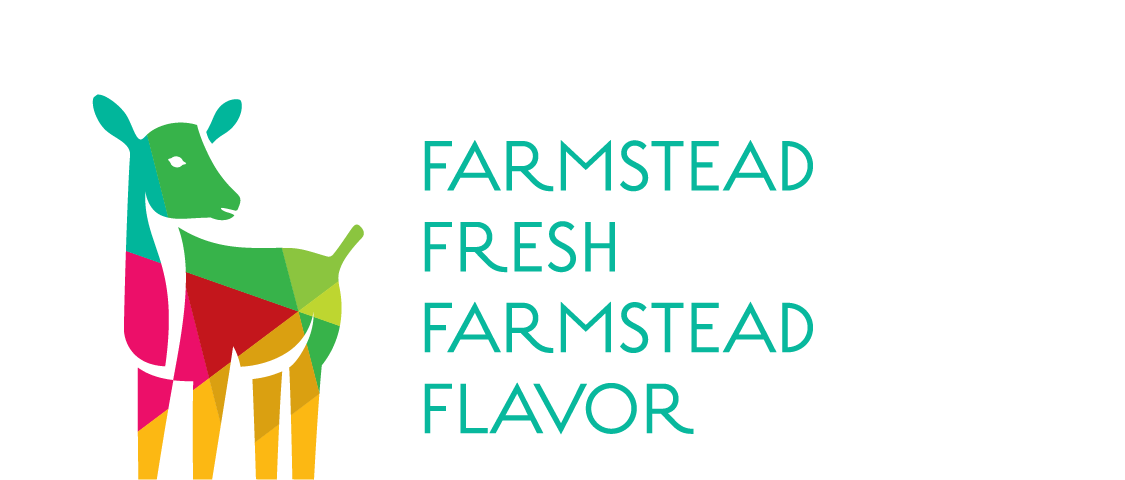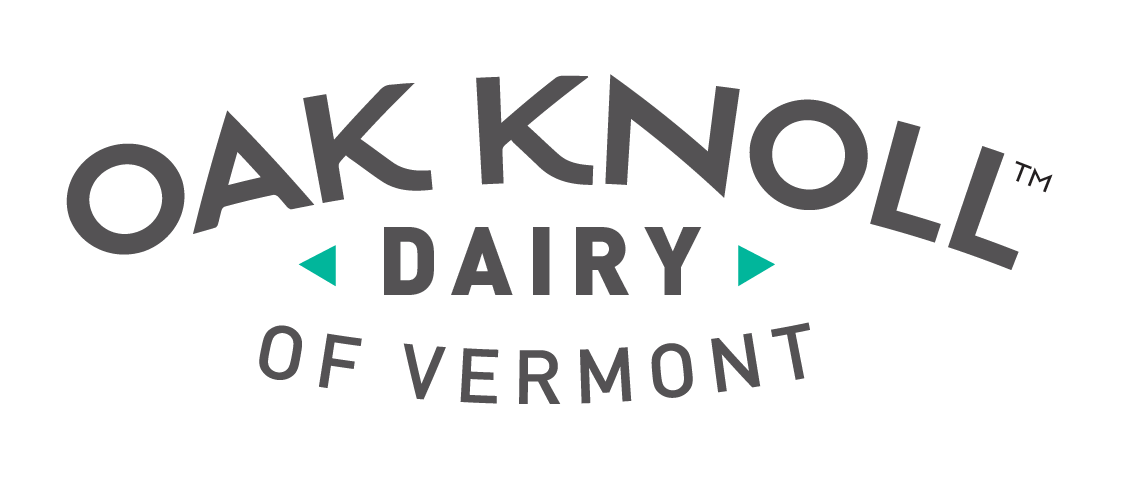
IT’S A NUTRITIOUS TASTE OF
VERMONT’S NORTHEAST KINGDOM

Our Products
Like a reliable friend, we aim to make you smile with the purest, freshest, best-tasting goat’s milk bottled at our family farm. Well-loved by everyone, ages one to 101, you’ll find more delight in a cup of coffee, a creamy recipe, or on your kiddo’s face with Oak Knoll Dairy.

100% Pure Whole Goat Milk
Oak Knoll Dairy goat milk is sure to find its place in your day. Whether you're enjoying it in your morning cup of coffee, swapping it for cow’s milk in your kid’s favorite dish, or you're savoring it ice cold with a decadent baked good, goat milk is right for so many reasons. It's no wonder it’s the world’s most popular dairy milk! So go ahead and indulge in the good life with goat's milk from Oak Knoll Dairy.
Rich, Chocolately Whole Goat Milk
This velvety smooth milk is packed with protein and calcium, making it the perfect pick-me-up. It's made with real cocoa and lightly sweetened with cane sugar for a touch of sweetness that won't weigh you down. Give yourself a glass of this wholesome goodness from Oak Knoll Dairy. Your body will thank you for it.
Enjoy the rich taste of real nutritious milk with 8g of protein
Feel good with easier digestibility than cow’s milk
Bottled on our farm for ultimate freshness

The Benefits Of Goat Milk
Goat’s milk is quickly becoming a favorite in the U.S., and here’s why.
The Satisfying Taste of Real Milk
Our customers are usually surprised that high-quality, properly handled goat’s milk is light, sweet and nearly indistinguishable from cow’s milk. A lot of people can’t tell the difference.
Easier to Digest Than Cow’s Milk
The fat globules in goats are smaller, which makes them more easily broken up and absorbed by your body! ¹
Goat's milk also helps digestion with more prebiotics (called oligosaccharides) than cow’s milk. Many of the same prebiotics in goat’s milk are found in human breast milk. They inhibit harmful bacteria and promote beneficial gut bacteria. ²
Builds Strong Bodies with Essential Nutrients
Better digestion means you get more of the essential nutrients you need like calcium, Biotin, potassium, vitamin B5, and vitamin A. Research shows your body can better absorb nutrients in goat’s milk than in cow’s milk. ³
Dairy Milk with Lower Lactose
All milk has natural sugar (lactose) in it. Some people feel bloated after they have milk because their bodies don’t have enough of the enzyme lactase to break it down. Goat’s milk has less lactose than cow’s milk, making for happier bellies. ⁴
If you have a cow milk allergy or are lactose intolerant, chat with your doctor to see if goat’s milk is right for you.
Less Processed Than Plant “Milk”
Say goodbye to soy lecithin and gellan gum. Goat milk is real milk with more of the rich, creamy taste and nutrition you want and none of the artificial flavors, preservatives, or processed stuff you don’t.
References:
1. Tomotake H et al (2006). Comparison between Holstein cows’ milk and Japanese-Saanen goat milk in fatty acid composition, lipid digestibility and protein profile. Biosci Biotechnol Biochem 70: 2771-2774
2. Kiskini A and Difilippo E (2013). Oligosaccharides in goat milk: structure, health effects and isolation. Cell Mol Biol 59: 25-30
3. Aliaga I. L., Alferez M. J. M., Barrionuevo M., Lisbona F. & Campos M. S. 2000. Influence of goat and cow milk on the digestive and metabolic utilization of calcium and iron. J. Physiol. Biochem. 56: 201-208.
4. Clark S and Bárbara Mora García M (2017). 100-Year Review: Advances in goat milk research. Journal of Dairy Science.

FAQ’s
-
We have a herd of 500 goats. 70% are adult milking goats and 30% are juvenile females. Additionally we keep 4-10 breeding males to service our herd’s reproductive needs.
-
We have 3 main breeds: saanen, alpine, and lamancha. These traditional dairy breeds perform best in a commercial environment and collectively produce balanced and versatile milk that is good for cheese making, yogurt production, and bottling. Between these breeds we aim to maintain 25% purebred, therefore 75% of our herd is a cross-bred combination of the 3 breeds.
-
Our milk is pasteurized through a high-temperature short-time pasteurizer (HTST) at 165 degrees. Our state-of-the-art system ensures the safest prod uct with the best taste and highest level of nutritional retention.
-
Bridgman Hill Farm feeds their goats a dry hay TMR ration that consists of: New England grasses, mostly rye and orchard, mixed with a grain pellet that is predominantly composed of corn, soy beans, canola, and minerals. We add moisture to it, usually water mixed with cheesemaking byproduct whey. Other ingredients we put in for palatability are hemp and molasses.
TMR stands for total mixed ration, which means that we design a ration of ingredients with the help of a professional small nutritionist to make sure the goats are getting a balanced array of nutrition to optimize health, longevity, energy, reproduction, and milk production. It’s an intricate balance of starches, fibers, sugars, and protein, and it changes throughout a goats age, stage of lactation and/or stage of gestation. Our nutrition management program is something we take a lot of pride in, and our herd is happy, healthy, bright, shiny, and full of energy, life, and of course milk.
-
We’re currently conducting a cost analysis on feeding our herd GMO Free ingredients. It is something we’d like to offer as long as it makes financial sense to do so and as long as it fits with what our customers are seeking. Feedback is always welcomed, we love to hear from our supporters. Our goal as environmentally minded farmers is to push the industry toward evolution and sustainability in any and all directions possible. Feeding our goats unadulterated forages and grains that originated in nature, is something we’ve always striven for. Becoming GMO Free certified wouldn’t force us to change much, but it would become an additional commitment and statement highlighting our goals and intentions as farmers and human beings.
-
In order to keep bottled milk orders fulfilled year round we have to keep goats in lactation, our farm knows no seasonality. We accomplish this feat via two main pathways. The first is by keeping goats in milk for longer than usual lactations. This is known as extended lactation and is a tactic that has been mastered predominantly in the Netherlands. The gist of it is that through tight management of nutrition and production data, we’re able to keep animals in peak milk for an extended period of time. The average lactation length in our adult herd is currently 600 days, while it is closer to 400 days in our first fresheners. The industry standard is 305 days. Extending lactations through tighter nutritional management means that goats do not have the burden of pregnancy as often as they might on more traditionally managed farms, it also means more milk in the tank throughout the calendar year. It’s a win-win.
-
Annie and Ryan have an intricate network of connections throughout the goat industry and know where to source the best production genetics available across the United States. Bridgman Hill Farm does not rely on artificial insemination at this time for any of its reproduction. Since we track the genealogy of our entire herd and know the dam and sires of all our goats, we often keep some of our own genetics from time to time since our data analysis can tell us who our best goats are at a quick glance. We use data derived from our parlor software (daily milk production) and cross reference component testing along with conformation to continually improve the genetics of our herd.
-
We generate a lot of goats kids every year and take pride in finding value-added markets for every one of them. Since we are a startup farm, we keep the bulk of our females kids for our own expanding herd, but sell some to select producers looking to grow and improve production metrics. We do keep a small number of our own bucks for breeding stock, but mostly the buck kids enter the meat sector. We do business with various partners who raise and finish goats throughout New England. Goat meat is the most consumed red meat on the planet and its popularity is growing here in America. It’s an excellent meat to cook as it is mild, lean, and versatile. Like most animal protein, the quality has a lot to do with feed, nutrition, and quality of life.
-
For several very important reasons, we take kids from their mom’s at birth and raise them ourselves in youngstock facilities. This is done to minimize the spread of disease, maximize kid survival rates, optimize nutrition, and minimize emotional strain. Colostrum is diverted and kept separate to be fed to new born kids after it has been heat-treated. Heat-treating is a process similar to pasteurization but happens at a much lower temperature, for a longer period of time, which ensures an effective bacteria kill without damaging or denaturing antibodies, immunoglobulin, or fats and proteins. We make sure each kid receives at least two 8 oz bottle feedings of heat-treated colostrum within 12 hours of birth. This provides the kids with the right building blocks for an effective immune system and the right nourishment to transition from womb life to the wild and unpredictable outside world.
Feeding heat-treated colostrum as opposed to powdered purchased product means that our goats are getting healthy doses of endemic and indigenous antibodies from their own herd, effectively building immunity to the specific bugs and viruses common in our goats, our environment, and our region. This makes for an incredible foundation of herd health to which we owe a lot of our success.
-
We do re-home older goats often and offer direct sales of bucklings throughout the year. If you live locally and are interested in goats, reach out to info@ bridgmanhillfarm.com for more information.


